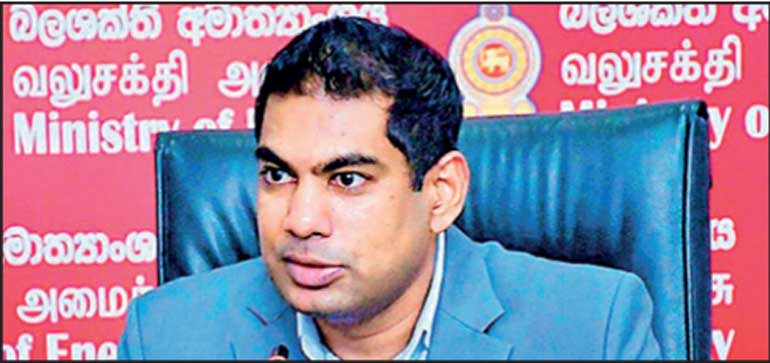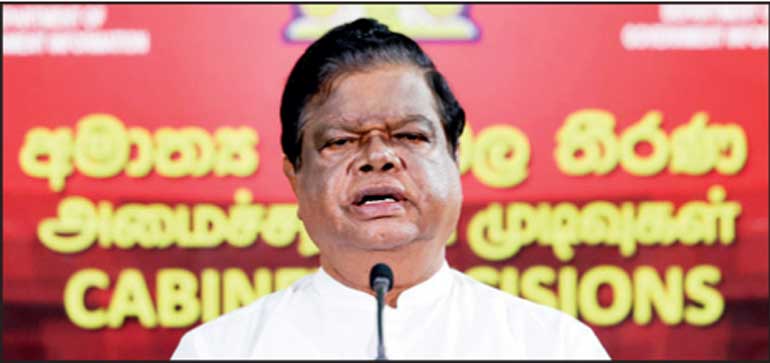Saturday Apr 05, 2025
Saturday Apr 05, 2025
Wednesday, 3 July 2024 00:20 - - {{hitsCtrl.values.hits}}

Power and Energy Minister Kanchana Wijesekera

Cabinet Co-Spokesman and Minister Bandula Gunawardena
By Charumini de Silva
In a bid towards boosting the adoption of sustainable energy, the Cabinet of Ministers on Monday approved a new tariff calculation formula for renewable energy projects.
The move was taken in line with the Sri Lanka Electricity Act, No. 20 of 2009 and its subsequent amendments, which mandate that renewable energy projects with a capacity of 10 MW or less enter into a standard power purchase agreement under a technology-based Feed-In Tariff (FiT) system.
Despite Cabinet approval on 13 March 2023, for the implementation of a variable tariff system, only a few developers have signed the agreements. To address this, a committee was established, comprising representatives from the Power and Energy Ministry, the Finance, Economic Stabilisation and National Policies Ministry, the Ceylon Electricity Board, the Sri Lanka Sustainable Energy Authority and the Central Bank of Sri Lanka.
“The committee was tasked with making recommendations on the calculation of renewable energy tariffs. Following the committee’s recommendations, the Cabinet of Ministers has approved the proposal presented by the Power and Energy Minister Kanchana Wijesekera to accept the new tariff calculation formula and implement the proposed tariff revisions,” Cabinet Co-Spokesman and Minister Bandula Gunawardena said yesterday.
Speaking at the weekly post-Cabinet meeting media briefing yesterday, he said the new tariff system aims to provide a fair and attractive rate for renewable energy producers, ensuring that the investment in green energy is both viable and profitable.
The new tariff system is expected to encourage more developers to participate in renewable energy projects, thereby accelerating the country’s transition to sustainable energy sources.
Last week, Minister Wijesekera said Sri Lanka achieved over 1,000 MW from solar power generation by June 2024, with 944 MW from rooftop solar and 156 MW from ground mount solar connected to the national grid.
He also assured that the country is on track to reach over 1,000 MW from rooftop solar by the end of the year, with a long-term target of 150 MW per year for the next four years. “In the first five months of the year, 132 MW have already been connected to the national grid,” he noted.

Discover Kapruka, the leading online shopping platform in Sri Lanka, where you can conveniently send Gifts and Flowers to your loved ones for any event including Valentine ’s Day. Explore a wide range of popular Shopping Categories on Kapruka, including Toys, Groceries, Electronics, Birthday Cakes, Fruits, Chocolates, Flower Bouquets, Clothing, Watches, Lingerie, Gift Sets and Jewellery. Also if you’re interested in selling with Kapruka, Partner Central by Kapruka is the best solution to start with. Moreover, through Kapruka Global Shop, you can also enjoy the convenience of purchasing products from renowned platforms like Amazon and eBay and have them delivered to Sri Lanka.
Discover Kapruka, the leading online shopping platform in Sri Lanka, where you can conveniently send Gifts and Flowers to your loved ones for any event including Valentine ’s Day. Explore a wide range of popular Shopping Categories on Kapruka, including Toys, Groceries, Electronics, Birthday Cakes, Fruits, Chocolates, Flower Bouquets, Clothing, Watches, Lingerie, Gift Sets and Jewellery. Also if you’re interested in selling with Kapruka, Partner Central by Kapruka is the best solution to start with. Moreover, through Kapruka Global Shop, you can also enjoy the convenience of purchasing products from renowned platforms like Amazon and eBay and have them delivered to Sri Lanka.